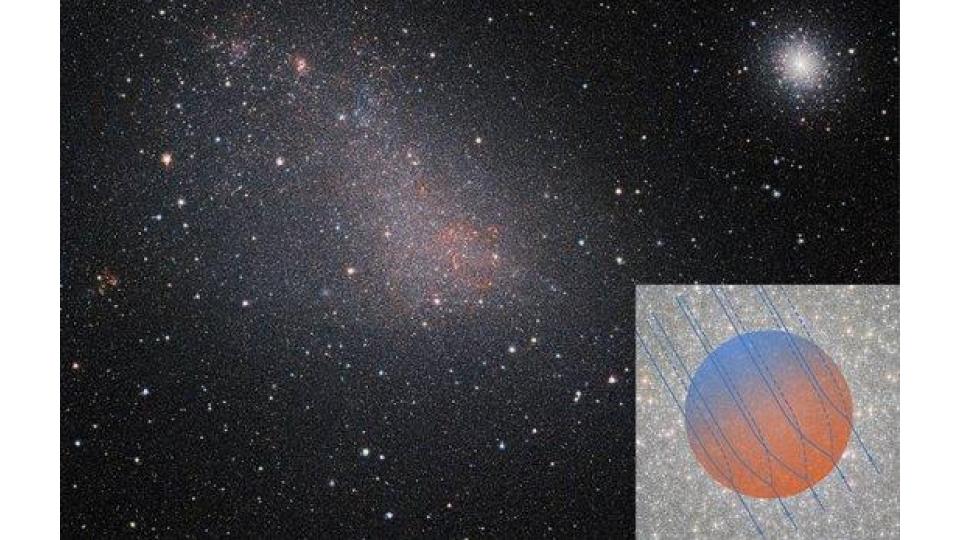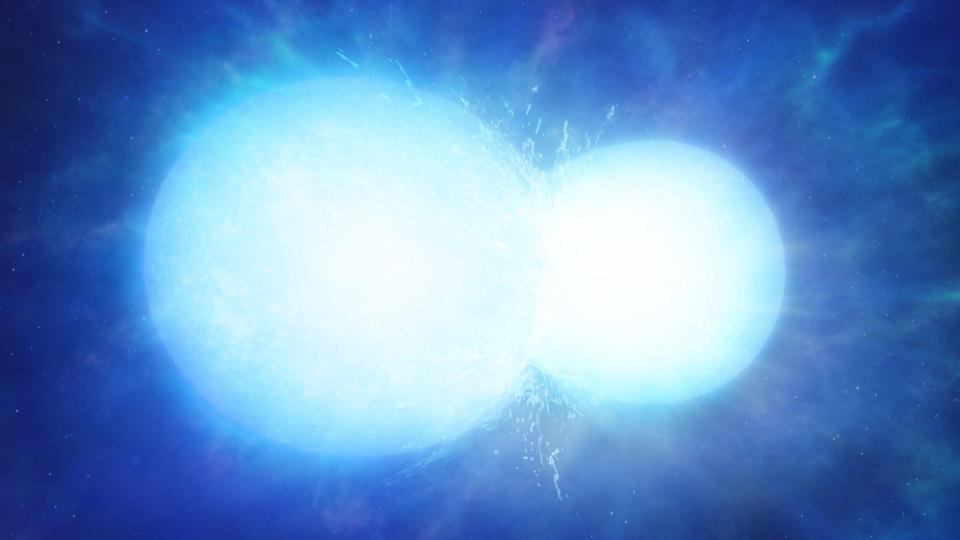Today’s news includes Pulsars being used to detect the Milky Way’s magnetic field, how a seriously oversized white dwarf was able to form, and new science about the search for alien atmospheres that was done in a Lunar Eclipse.
Today’s news is of the awesome and straightforward and why didn’t we think of that before variety, and it’s all so awesome it is hard to figure out where to start. For lack of a better reason, let’s go with the prettiest story first.

© ESO/VISTA VMC (background image); F. Abbate et al., Nature Astronomy (inset)
- Globular cluster billowing in the Galactic wind (Max Planck)
One of the most beautiful and confusing globular clusters associated with our Galaxy is 47 Tucana or Tuc, a Southern Hemisphere system that can be seen right off the edge of the much larger Small Magellanic Cloud. This system of millions of stars is both one of the largest and oddest globular clusters we have locally. Unlike other systems, 47 Tuc appears to have undergone multiple periods of star formation, has gas in the cluster, and it just might have a black hole in its center. The weirdo system is home to numerous pulsars, and it is this population of spinning neutron stars that makes 47 Tuc the perfect laboratory to test for galactic magnetic fields.
47 Tuc is located 13,000 ly away in the galactic halo. It had been unclear how much of an effect that our Milky Way’s magnetic field might have at this distance. We simply hadn’t had a way to measure it! Well, thanks to new Parkes Radio telescope observations of this system’s 25 pulsars, we see the presence of a strong magnetic field that is running perpendicular to the galactic disk. This can be seen in how their signals are spread out across different frequencies by the magnetic fields as a function of where they are in the cluster. Pulsars on the far side of the cluster have their signals dispersed more than pulsars on the near side. This strong field was surprising, and it appears that the magnetic field is amplified by interactions of the galactic wind and the cluster material. This was observationally a challenging result to get at, but the physics is straight forward – look at how a magnetic field interacts with a blob of stars in gas. Replicated this result might be tricky however. This kind of dispersion is possible in systems like 47 Tuc that have gas, but … there really aren’t other systems like 47 Tuc.
Still, even if we can’t replicate this result using other globular clusters, this result does confirm our galaxy has one heck of an extensive magnetic field. This work appears in the journal Nature and was led by Frederico Abbate.
From one set of dead stars to another, we now turn from prolific pulsars to overweight white dwarf stars.

- Two stars merged to form massive white dwarf (Warwick U)
In new research coming out of Warwick University, an surprisingly large white dwarf has been found in data from the Gaia mission. This system, cataloged as WDJ 0551+4135, appears to be the result of a stellar merger that just squeaked in under the supernova triggering weight limit. And not only was this star made in a stellar merger, but it appears to be the merger of two small white dwarf stars.
Folks, the more we look at the universe, the more weird stuff we’re going to find.
This bloated star was observed in detail by the William Herschel telescope and found to have a surface composition of both Hydrogen and Carbon. While these elements are common on white dwarfs, they aren’t generally found together. Carbon white dwarfs are formed in the deaths of larger stars that start out a few solar masses in size, and hydrogen come from smaller stars. To see both… means both kinds of stars were born and died and merged. And somehow didn’t explode. This star appears to be 1.14 solar masses – twice the average of a white dwarf – and these systems max out and go boom at 1.4 solar masses. This is turning into the academic year when we learn stars just like to merge, and this is a pretty common thing in our universe.

In our final story of the day, scientists trying to learn how our planet’s atmosphere might appear to other worlds have finally sorted a clever experiment. When we measure the compositions of alien atmospheres, we do it by looking for their star’s light to pass through their atmospheres, and then we measure their atmosphere as the difference between starlight and starlight plus atmosphere. Compositions are measured with spectrographs that allow us to see the complex dips and wiggles in the random of light from a system. This isn’t pretty science. This is science by graph.
In January 2019, astronomers pointed the Large Binocular Telescope at the moon during a lunar eclipse and looked at the blood red moon that was illuminated strictly by sunlight that had been bent through the Earth’s atmosphere. As the eclipse progressed, astronomers were able to make out more and more elements and molecules in our atmosphere in the reflected sunlight. It is clear that distant observers would be able to see that we have an atmosphere rich in molecular oxygen and water vapor, as well as elements like sodium, calcium, and potassium. And I have to admit, I didn’t know all those elements were in our atmosphere because they aren’t anywhere near the top of the atmosphere’s ingredient list. This is an experiment we can do under different conditions to build a good understanding of just how eclipses can reveal our world’s hidden characteristics. Our world after all, is just one of 1000s in our galaxy, and if we can figure out how we look, it will help us understand how we see others.
<———————>
And that rounds out our show for today.Thank you all for listening. Today’s script was written by Pamela Gay. The Daily Space is produced by Susie Murph, and is a product of the Planetary Science Institute, a 501(c)3 non profit dedicated to exploring our Solar System and beyond. We are here thanks to the generous contributions of people like you. Want to become a supporter of the show? Check us out at Patreon.com/cosmoquestx


 We record most shows live, on Twitch. Follow us today to get alerts when we go live.
We record most shows live, on Twitch. Follow us today to get alerts when we go live.